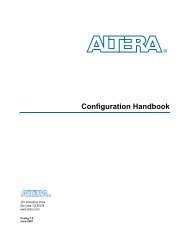Serial real-time clocks (RTCs) with alarm
Serial real-time clocks (RTCs) with alarm
Serial real-time clocks (RTCs) with alarm
You also want an ePaper? Increase the reach of your titles
YUMPU automatically turns print PDFs into web optimized ePapers that Google loves.
Clock operation<br />
M41T62/63/64/65<br />
3.2 Calibrating the clock<br />
The M41T6x <strong>real</strong>-<strong>time</strong> clock is driven by a quartz controlled oscillator <strong>with</strong> a nominal<br />
frequency of 32,768 Hz. This provides the <strong>time</strong>-base for the RTC. The accuracy of the clock<br />
depends on the frequency accuracy of the crystal, and the match between the capacitive<br />
load of the oscillator circuit and the capacitive load for which the crystal was trimmed. The<br />
M41T6x oscillator is designed for use <strong>with</strong> a 6 - 7 pF crystal load capacitance. When the<br />
calibration circuit is properly employed, accuracy improves to better than ±2 ppm at 25 °C.<br />
The oscillation rate of crystals changes <strong>with</strong> temperature (see Figure 21 on page 25).<br />
Therefore, the M41T6x design employs periodic counter correction. The calibration circuit<br />
adds or subtracts counts from the oscillator divider circuit at the divide by 256 stage, as<br />
shown in Figure 22 on page 25. The number of <strong>time</strong>s pulses which are blanked (subtracted,<br />
negative calibration) or split (added, positive calibration) depends upon the value loaded into<br />
the five calibration bits found in the calibration register. Adding counts speeds the clock up,<br />
subtracting counts slows the clock down.<br />
The calibration bits occupy the five lower order bits (D4-D0) in the calibration register (08h).<br />
These bits can be set to represent any value between 0 and 31 in binary form. Bit D5 is a<br />
sign bit; '1' indicates positive calibration, '0' indicates negative calibration. Calibration occurs<br />
<strong>with</strong>in a 64 minute cycle. The first 62 minutes in the cycle may, once per minute, have one<br />
second either shortened by 128 or lengthened by 256 oscillator cycles. If a binary '1' is<br />
loaded into the register, only the first 2 minutes in the 64 minute cycle will be modified; if a<br />
binary 6 is loaded, the first 12 will be affected, and so on.<br />
Therefore, each calibration step has the effect of adding 512 or subtracting 256 oscillator<br />
cycles for every 125,829,120 actual oscillator cycles, that is +4.068 or –2.034 ppm of<br />
adjustment per calibration step in the calibration register.<br />
Assuming that the oscillator is running at exactly 32,768 Hz, each of the 31 increments in<br />
the calibration byte would represent +10.7 or –5.35 seconds per day which corresponds to a<br />
total range of +5.5 or –2.75 minutes per month (see Figure 22 on page 25).<br />
Two methods are available for ascertaining how much calibration a given M41T6x may<br />
require:<br />
● The first involves setting the clock, letting it run for a month and comparing it to a known<br />
accurate reference and recording deviation over a fixed period of <strong>time</strong>. Calibration<br />
values, including the number of seconds lost or gained in a given period, can be found<br />
in application note AN934, “How to use the digital calibration feature in TIMEKEEPER ®<br />
and serial <strong>real</strong>-<strong>time</strong> clock (RTC) products.” This allows the designer to give the end user<br />
the ability to calibrate the clock as the environment requires, even if the final product is<br />
packaged in a non-user serviceable enclosure. The designer could provide a simple<br />
utility that accesses the calibration byte.<br />
●<br />
The second approach is better suited to a manufacturing environment, and involves the<br />
use of either the SQW pin (M41T62/63/64) or the IRQ/FT/OUT pin (M41T65). The<br />
SQW pin will toggle at 512 Hz when RS3 = '0,' RS2 = '1,' RS1 = '1,' RS0 = '0,' SQ<br />
WE = '1,' and ST = '0.' Alternatively, for the M41T65, the IRQ/FT/OUT pin will toggle at<br />
512 Hz when FT and OUT bits = '1' and ST = '0.'<br />
Any deviation from 512 Hz indicates the degree and direction of oscillator frequency shift at<br />
the test temperature. For example, a reading of 512.010124 Hz would indicate a +20 ppm<br />
oscillator frequency error, requiring a –10 (XX001010) to be loaded into the calibration byte<br />
for correction. Note that setting or changing the calibration byte does not affect the<br />
frequency test or square wave output frequency.<br />
24/44 Doc ID 10397 Rev 19

















